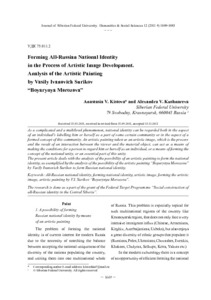Формирование общероссийской национальной идентичности в процессе развития художественного образа. Анализ живописного произведения Василия Ивановича Сурикова «Боярыня Морозова»
Скачать файл:
URI (для ссылок/цитирований):
https://elib.sfu-kras.ru/handle/2311/2609Автор:
Кистова, А.В.
Kistova, Anastasia V.
Кушнарева, А.В.
Kushnareva, Alexandra V.
Дата:
2011-12Аннотация:
As a complicated and a multilevel phenomenon, national identity can be regarded both in the aspect
of an individuals labelling him or herself as a part of some certain community or in the aspect of a
formed concept of this community. An artistic painting taken as an artistic image, which is the process
and the result of an interaction between the viewer and the material object, can act as a means of
making the conditions for a person to regard him or herself as an individual, or a means of forming the
concept of the national unity, or an essential part of this unity.
The present article deals with the analysis of the possibility of an artistic painting to form the national
identity, as exemplified by the analysis of the possibility of the artistic painting Boyarynya Morozova
by Vasily Ivanovich Surikov to form Russian national identity. Общенациональная идентичность как явление сложное и многоуровневое может быть
рассмотрена в аспекте индивидуального отнесения себя отдельным человеком к определенной
общности людей или к сложившемуся представлению об этой общности. В качестве одного
из средств формирования представления об общенациональном единстве и создания условий
для личностного ощущения себя отдельным человеком необходимой частью этого единства
может выступать произведение живописи, понимаемое как художественный образ - процесс
и результат взаимодействия зрителя и произведения-вещи.
В статье предлагается рассмотрение возможностей произведения изобразительного
искусства (живописи) по формированию общенациональной идентичности на материале
анализа возможностей картины Василия Ивановича Сурикова «Боярыня Морозова» по
формированию общероссийской национальной идентичности.
Коллекции:
Метаданные:
Показать полную информациюСвязанные материалы
Показаны похожие ресурсы по названию, автору или тематике.
-
ALLEGORY AND SYMBOLICS IN THE ARTWORKS OF LEONARDO DA VINCI.
Ямалетдинов, Сергей Федорович; Мусат, Раиса Павловна (2018-10)The study is aimed at revealing the deep meanings inherent in the artwork "Adoration of the Magi" by Leonardo da Vinci with the help of the system of the artistic universalism. The main methods used are comparative-historical, ... -
Art groups in Russia After 1917
Pokrovskaya, Natalya V.; Покровская, Н.В. (Сибирский федеральный университет. Siberian Federal University., 2014-09)The main purpose of the present article is to study the art groups existing in Russia after 1917, included into the stream of world artistic culture. The present work presents the analysis of Russian Soviet pieces of art ... -
From Cultural History of Eastern Trans-Baikal Region: Musical Culture of Chita Within a Context of Artistic Culture of the City (pre-October Period)
Belonosova, Irina V.; Белоносова, И.В. (Сибирский федеральный университет. Siberian Federal University., 2014-03)The paper studies the process of formation of the cultural environment of the city of Chita – one of the centers of Eastern Trans-Baikal in the pre-October period. The paper features socio-cultural panorama of Chita and ... -
The Truth of the Literary Past: (on the Issue of the Narrative Peculiarity in A. Solzhenitsyn’s Epic ‘The Red Wheel’)
Sidor, Monika; Сидор, Моника (Сибирский федеральный университет. Siberian Federal University., 2015-06)The present article tackles the artistic method used by Solzhenitsyn in his work “The Red Wheel”. The starting point for consideration is the writer’s statement that this work of art is not an ordinary historical novel ... -
D.V. Pivovarov’s Concept of the Ideal as the Basis of Modern Theory of Fine Arts
Zhukovsky, Vladimir I.; Жуковский, В.И. (Сибирский федеральный университет. Siberian Federal University, 2018)The article reveals the methodological principles of the Russian researcher D.V. Pivovarov’s synthetic theory of the ideal, which laid the foundation for the research of regularities of an ideal-forming process in fine ...

